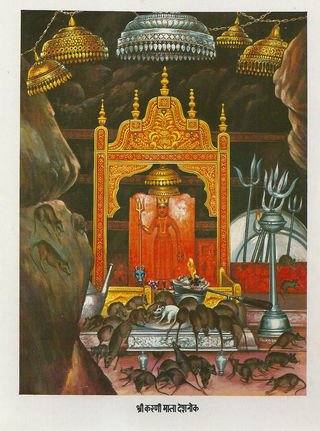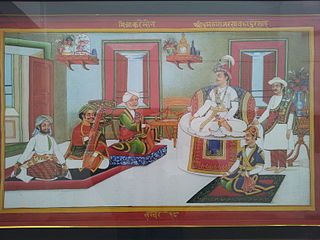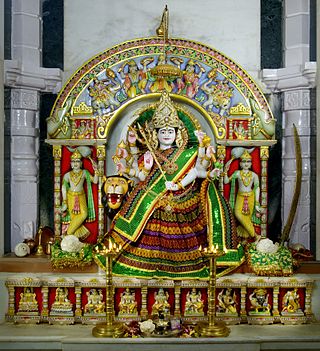Related Research Articles

Parashurama, also referred to as Rama Jamadagnya, Rama Bhargava and Virarama, is the sixth avatar among the Dashavatara of the preserver god Vishnu in Hinduism. He is believed to be one of the Chiranjivis (Immortals), who will appear at the end of the Kali Yuga to be the guru of Vishnu's tenth and last incarnation, Kalki.

Kamadhenu, also known as Surabhi, is a divine bovine-goddess described in Hinduism as the mother of all cows. She is a miraculous cow of plenty who provides her owner whatever they desire and is often portrayed as the mother of other cattle. In iconography, she is generally depicted as a white cow with a female head and breasts, the wings of a bird, and the tail of a peafowl or as a white cow containing various deities within her body. Kamadhenu is not worshipped independently as a goddess. Rather, she is honored by the Hindu veneration of cows, who are regarded as her earthly embodiments.

The Magars, also spelled Mangar and Mongar, are Tibeto-Burman ethnic group native to Nepal, representing 6.9% of Nepal's total population according to the 2021 Nepal census. They are one of the main Gurkha tribes.
Lohana are a trading or mercantile jāti mostly in India and also in Pakistan.
In Indian culture, the Agnivanshi are people who claim descent from Agni, the Vedic god of fire. The Agnivanshi lineage is one of the lineages among the Rajput clans, the others being the Suryavanshi

Karni Mata, known by various names such as Bhagwati, Mehaai, Jagdamba, and Kiniyani is a Hindu Goddess of power and victory described as a warrior sage, who lived between 14th and 16th centuries in Western Rajasthan. Karni Mata is the tutelary deity of the Rajputs and Charans of northwestern India. As a Sagati, she is also worshipped as an incarnation of Hinglaj or Durga. She is the official deity of the royal families of Bikaner and Jodhpur. Karniji played an important role in shaping the history of the region. She is intimately associated with the establishment of the Rajput hegemony in the region. With her blessings, Rao Jodha and Rao Bika founded the kingdoms of Jodhpur and Bikaner. At the request of the Maharajas of Bikaner and Jodhpur, she laid the foundations of Bikaner Fort and Mehrangarh Fort, the two most important forts in the region. She lived an ascetic life and was widely revered during her lifetime. Indian Army troops from the Marwar region also regard Karni Mata as their patron deity.

A kuladevata, also known as a kuladaivaṃ, is an ancestral tutelary deity in Hinduism and Jainism.

Thapa (pronunciation:) is a common surname used by Chhetri and Magar people of Nepal it is also used in India to lesser extent.

Hinglaj is an important Hindu pilgrimage place in Balochistan, Pakistan and Kuldevi of many Jats, Rajput, Charan, Rajpurohits and other Hindu Communities of India. It is situated in Balochistan province about 250 km west-northwest of Karachi. The Shri Hinglaj Mata mandir which is the largest Hindu pilgrimage centre in Pakistan is located here.

A Dangerous Path is a fantasy novel, the fifth book in the Warriors series, written under the pseudonym of Erin Hunter. This individual book was written by Cherith Baldry. The story centers around Fireheart, deputy of ThunderClan, as he attempts to keep his Clan safe with the help of his ailing leader, while fighting off outside threats such as dogs and enemy Clans.

Warriors: Power of Three is the third arc in the Warriors juvenile fantasy novel series about anthropomorphic feral cats. The arc comprises six novels which were published from 2007 to 2009: The Sight, Dark River, Outcast, Eclipse, Long Shadows, and Sunrise. The novels are published by HarperCollins under the pseudonym Erin Hunter, which refers to authors Kate Cary, Cherith Baldry, Tui Sutherland and plot developer/editor Victoria Holmes. Power of Three details the experiences of protagonist of the first series Firestar's three grandchildren, initially known as Jaykit, Hollykit, and Lionkit, whom a prophecy foretells will have "the power of the stars in their paws". The arc's major themes deal with forbidden love, the concept of nature versus nurture, and characters being a mix of good and bad. Though the novels have appeared on the New York Times Bestseller List and have been nominated for several awards, none of the novels in Warriors: Power of Three have won a significant literary award.
Bhaiband, meaning “brotherhood”, are a Hindu jāti within the Sindhi caste of India and Pakistan.

Devnarayan is a folk deity from Rajasthan, India. He was an incarnation of Vishnu and he is worshipped mostly in Rajasthan and north-western Madhya Pradesh. According to tradition, he was born to Sri Savai Bhoj and Sadu mata on the seventh day of the bright half of the month of Maagh in the Hindu Calendar in Vikram Samvat 968 .According to one view historical Devnarayan belonged to 10th century of Vikram Samvat, according another view, he lived in between 1200-1400. The first view appears nearer to truth.

Ashapura Mata is an aspect of Devi, a Hindu goddess. She is one of the kuldevis of Kutch and Rajasthan, and the Jadeja clan of Gujarat, Chauhans and Patiyats inhabiting the western Indian provinces. She is a goddess regarded to fulfill the wishes of her adherents.

Harsidhhi, one of the aspects of Durga, is a regional Hindu goddess, popular in Gujarat, Madhya Pradesh, adjoining Maharashtra states of India.
Bhanushali is a Hindu community. The majority reside in Kutch district of the Indian state of Gujarat. Some are also found in the Saurashtra region and other parts of Gujarat. Some have also moved to Thane and Mumbai region of Maharashtra. They speak Kutchi language which is alike Gujarati.
Rana Jashraj was elevated to the name Veer Dada Jashraj and he was worshiped as kuladevata by the Lohana caste. In memory of Jashraj, Vasant Panchami is celebrated as a balidaani diwas of Veer Dada Jashraj.
Rana Vachhraj was a king of Lohar-Gadha in 13th century AD in what is now Afghanistan. Rana was the elder son of Rana Vasupal and elder brother of Rana Jashraj and their only sister Harkor.
The Amils are a Sindhi sub-group of Bhaiband Lohana. The word "Amil" has its origin in the Persian word "amal". Amils used to work in Administration in Government services.
Oni Gozen (鬼御前) was a Japanese noble lady and onna-musha from the Sengoku period. She was the wife of Hoashi Akinao (帆足鑑直) the retainer of Ōtomo clan. She was a military commander who actively participated in the Kyushu campaign of 1586–1587, helping to repel the Shimazu army from the Ōtomo clan.
References
- 1 2 3 "History - Fact has always been stranger than fiction". Archived from the original on 2013-09-10.
- ↑ Lohanas in Diaspora